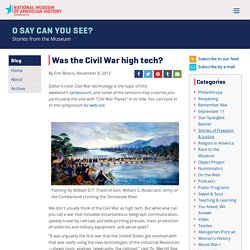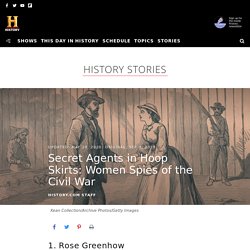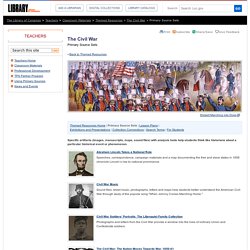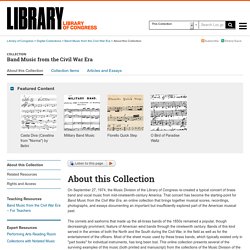

Battle of the Ironclads. National Museum of American History. Editor's note: Civil War technology is the topic of this weekend's symposium, and some of the sessions may surprise you, particularly the one with "Civil War Planes" in its title.

You can tune in to the symposium by webcast. Painting by William D.T. Travis of Gen. William S. How Technology Shaped the Civil War. Editor’s note: The following is the introduction to a special e-publication called Civil War Innovations.

Published in September 2012, the collection draws articles from the archives of Scientific American. Any Civil War buff is familiar with the technological advances of that era: the carnage caused when tactics failed to accommodate breech-loading rifled muskets and artillery pieces, the truly revolutionary introduction of armored ships and railroad networks, and the merely tantalizing deployment of submerged warships and reconnaissance balloons.
Historians still argue about the extent to which the Civil War was the first “modern” war, but it is impossible to deny that the technology with which it was fought foretold the ways in which future wars would become bigger, bloodier and more devastating. Fewer people realize, however, that a similar explosion in technological creativity occurred away from the battlefield. Civil War Innovations. 6 Freaky Weapons That Came Out Of The Civil War. If there is anything that drives innovation in science and technology, it’s a good old-fashioned war.

When you need to kill your enemies faster and deader than they kill you, governments are willing to try nearly anything, no matter how insane it sounds. That isn’t to say we haven’t gotten amazing technology from war. Rockets, microwaves and radar were all game-changing innovations during battle, but also have turned into essential pieces of our everyday lives, helping humanity even when we aren’t smashing and destroying someone else for looking at us funny. But while fighting Nazis happens to have also given us a new way to heat up a beef-and-bean burrito, every war has its hits, misses, and downright bat-guano ideas. 5 Most Lethal Weapons of the U.S. Civil War. The Civil War was by far the most deadly war in American history.

The bloody four-year conflict between the northern and southern states of the America would end up consuming the lives of an astounding 2 percent of the prewar national population—620,000 dead and a further 1.1 million wounded. The number of casualties is even more remarkable considering the most deadly weapons of the Industrial Revolution—the machine gun, the aircraft and the tank—hadn’t been invented yet. Secret Agents in Hoop Skirts: Women Spies of the Civil War. 1.

Rose Greenhow Known from a young age as “Wild Rose,” Rose O’Neal Greenhow ascended the ranks of Washington, D.C., society as the wife of a wealthy and prominent doctor. Her charmed life took a tragic turn in the 1850s, when her husband and five of their eight children died. In the months before the Civil War broke out, Greenhow, a fervent supporter of the Confederate cause, became the ringleader of a growing network of anti-Union spies. Renowned as a charming hostess and engaging conversationalist, she gleaned critical information from politicians and diplomats, passing along their secrets to Confederate General P.G.T. In July 1861, Greenhow obtained critical information about the Union Army’s planned attack of Manassas, Virginia. On August 23, 1861, Allan Pinkerton, head of the federal government’s newly formed secret service, arrested Greenhow and conducted a raid of her home. Intel in the CW1.
Women Spies of the Civil War. The former slave known for leading more than 300 people—including her elderly parents—to freedom as a conductor on the Underground Railroad was also a Union spy.

Born in Maryland around 1820, Tubman volunteered for the Union as a cook and a nurse before she was recruited by Union officers to establish a network of spies in South Carolina made up of former slaves. Tubman became the first woman in the country’s history to lead a military expedition when she helped Col. James Montgomery plan a night raid to free slaves from rice plantations along the Combahee River. On June 1, 1863, Montgomery, Tubman and several hundred black soldiers traveled up the river in gunboats, avoiding remotely-detonated mines that had been placed along the waterway.
When they reached the shore, they destroyed a Confederate supply depot and freed more than 750 slaves. After the war, Tubman tried to collect $1,800 for her service but was unsuccessful. Spies - The Civil War. Spying in the Civil War. Though neither the Union nor the Confederacy had a formal military intelligence network during the Civil War, each side obtained crucial information from spying or espionage operations.

From early in the war, the Confederacy set up a spy network in the federal capital of Washington, D.C., home to many southern sympathizers. The Confederate Signal Corps also included a covert intelligence agency known as the Secret Service Bureau, which managed spying operations along the so-called “Secret Line” from Washington to Richmond. As the Union had no centralized military intelligence agency, individual generals took charge of intelligence gathering for their own operations. General George B. McClellan hired the prominent Chicago detective Allan Pinkerton to set up the first Union espionage organization in mid-1861. Confederate Spies in Washington. Six Ways the Civil War Changed American Medicine. In 1862, U.S.

Surgeon General William Hammond put out a call to medical field officers in the Union Army: Send any specimens of morbid anatomy that might be valuable to military medicine and surgery. It might seem like a strange request, but the medical profession was in the midst of change—from a system based on tradition to one based on evidence. Civil War Battlefield Medicine. Civil War Medicine: An Overview of Medicine. Civil War Surgeons at Petersburg(Library of Congress) During the 1860s, doctors had yet to develop bacteriology and were generally ignorant of the causes of disease.
Generally, Civil War doctors underwent two years of medical school, though some pursued more education. Gettysburg National Military Park. Disease in the Civil War - Essential Civil War Curriculum. Civil War Medicine: An Overview of Medicine. Primary Source Sets - The Civil War - Themed Resources. Back to Themed Resources Specific artifacts (images, manuscripts, maps, sound files) with analysis tools help students think like historians about a particular historical event or phenomenon.

Abraham Lincoln Takes a National Role Speeches, correspondence, campaign materials and a map documenting the free and slave states in 1856 chronicle Lincoln’s rise to national prominence. The American Civil War: A collection of free online primary sources. Investigating Civil War Uniforms. Digital History. Music During the American Civil War. Band Music from the Civil War Era On September 27, 1974, the Music Division of the Library of Congress re-created a typical concert of brass band and vocal music from mid-nineteenth-century America.

That concert has become the starting-point for Band Music from the Civil War Era, an online collection that brings together musical scores, recordings, photographs, and essays documenting an important but insufficiently explored part of the American musical past. The cornets and saxhorns that made up the all-brass bands of the 1850s remained a popular, though decreasingly prominent, feature of American wind bands through the nineteenth century. Bands of this kind served in the armies of both the North and the South during the Civil War, in the field as well as for the entertainment of the officers. Most of the sheet music used by these brass bands, which typically existed only in "part books" for individual instruments, has long been lost.
A. Brass Band Journal. B. [Manchester Cornet Band Books]. [Port Royal Band Books]. Civil War Music - Primary Source Set. Skip navigation Library of Congress Teachers Suggestions enabled. The Library of Congress > Teachers > Classroom Materials > Primary Source Sets > Civil War Music Print Subscribe Share/Save Give Feedback. America's Civil War Magazine. Pint-Sized Heroes. Young Civil War drummers weren’t there just for show.
They played a vital role for both armies. ‘Grizzled’ Vets: In this stereoview, three Federal drummer boys—reportedly veterans of nine battles—pose at Fort Hamilton in Brooklyn, N.Y. (Library of Congress) Drumbeats governed Civil War soldiers. Over the din of the battlefield, drum calls were used to transmit commands—the long roll, for instance, was the signal to fall in under arms. Civil War. Black Soldiers in the Civil War. By Budge Weidman. Facts - The Civil War.